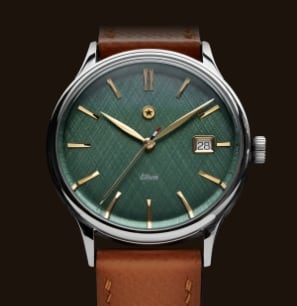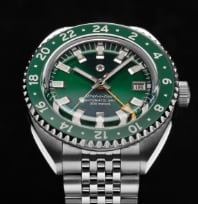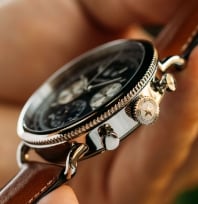What defines the value of a watch? Certainly not the price. Is it the case size? Watches in the last half-century have started to trend bigger, but size does not speak to the exterior beauty of a piece or to the nuanced internal machinery that helps give watches their singular, stylish appeal. We would like to propose this particular factor as being crucial: The movement.
The movement of a watch is the beating heart around which all other practical and aesthetic considerations must be designed and thus determines what a watch is and what it can be. Automatic watches, in particular, marry classic craftsmanship and modern ingenuity for a pragmatic and gorgeous solution to your daily needs. This article will examine what makes automatic watches special and showcases some of the best offerings under $500.
Mechanical, Automatic, and Quartz: Differences Between Watch Movements
Perhaps you are already familiar with automatic watches. Perhaps you are merely familiar with the phrase “watch movement.” It may even be that you are looking to find an entry point into the world of watches. Regardless of whether you are a connoisseur or an eager novice, it is essential when searching for a new watch to fully understand what sets it apart from the competition. For this reason, we will be briefly touching on other types of watch movements and what makes automatic watches uniquely attractive.
Simply put, the watch movement is the function that causes the movable parts within a watch to operate and allows the watch to accurately measure time. The three most prominent watch movements will be discussed: Quartz, mechanical, and, of course, automatic.
Quartz Watches
Quartz watches emerged during the latter half of the 20th century. Rather than relying on the fine-crafted machinery of their mechanical and automatic counterparts, quartz watches use battery-powered electrical currents in order to produce the vibrations that make a clock tick. Electricity is sent in controlled bursts to a quartz crystal, which then vibrates in a precise manner to cause the hands to move forward in the familiar ticking fashion.
Because of the movement, quartz watches may be marginally more accurate timekeepers than their counterparts. However, by virtue of their simple interior, quartz watches tend to lack the complicated caseback visuals that mechanical and automatic watches showcase elegantly.
Mechanical Watches
A word on nomenclature: All automatic watches are mechanical watches. In truth, there are two main types of watches: Electric and mechanical. Mechanical watches are then subdivided into nonwinding, often simply called mechanical, and automatic. However, mechanical watches as a whole predate automatic watches by centuries.
The earliest portable mechanical watches appeared in the late 15th century, though “portable” is a phrase to be used with a disclaimer: The earliest mechanical watches were so large that they had to be worn around one's neck or belt. The element that distinguishes mechanical watches from electronic watches is their movement. In mechanical watches, the movement is caused by a complex series of small machinery, powered by a slowly uncoiling wound-up spring.
The spring slowly unwinds into a series of gears, whose turning speed is controlled by a secondary spring, called a hairspring. Mechanical watches must be manually wound, and while they do showcase fine and delicate craftsmanship, they also become less accurate as they come unwound. In addition, they also require more upkeep than other movements.
Automatic Watches
Automatic watches still rely on inner machinery to properly measure time, but unlike their normal mechanical counterparts, they do not need to be manually wound. Rather, automatic watches are wound by the energy generated by the wearer's activities of daily life. This self-winding feature is the key difference between automatic watches and their counterparts.
An automatic watch’s movement is powered by a weighted rotor which turns in response to the user's wrist movements. As such, an automatic watch lives in a space where it exhibits both the detailed craftwork of mechanical watches and the low upkeep of quartz watches.
For these reasons, they offer the wearer a crucial solution in both form and functionality. An additional feature unique to automatic watches: The weighted rotor inside often adds a palpable weight to the watch, giving them a special sense of gravitas.
The Origins of the Automatic Watch
The earliest automatic watches appeared in the 1770s but failed to become popular due to their unreliability. During the 1770s, pocket watches were still the norm, and as such, the mechanisms remained too sedentary to be functional. Wristwatches, prior to the 20th century, were primarily seen as womenswear. They became popular across the entire market following military usage in the Boer War and WWI. A few short years later, in 1923, John Harwood claimed the first patents for automatic wristwatches. The need for larger internal mechanisms meant that automatic watches were often heftier than their mechanical counterparts, which contributed to the trend for the big watches we see today. A happy complication of the increased size is that automatic watches often have additional features, adding to their practicality and design.
The Best Automatic Watches Under $500
By this point, you have been introduced to the unique appeal which has helped automatic watches gain a foothold in the market for the last century.
Below, Jack Mason has collected some of the best automatic watches under $500 on the market, taking into careful consideration the special features which set them apart not only from other watches in general but other automatic watches in particular.
Pursuit Automatic Box Set: $289 & $319
The Pursuit Automatic Box Sets feature two different 42mm models, which we will discuss together and then separately. Both models feature sapphire crystal and 316L stainless steel cases to maximize protection and sleekness of appearance, as well as crisp Miyota 8215 movement. Included are SuperLuminova markings on the watch dial, allowing for easy readings at night. Inspired by a timeless pilot’s watch design, they both highlight an elegant caseback. This allows one a glance at the watch’s inner workings, which automatic watches are known for.
For $289, the Pursuit has an understated black case and dial, which you can accent in a tasteful monochrome with a black NATO strap or highlight more flashily with the tan Italian leather strap that comes included in the box set.
For $319, the Pursuit 2 features a more elegant, classic appearance, featuring a stainless steel case and a navy dial with gold accents. The watch comes with both a stainless steel chain-link bracelet band and a more neutral leather strap. Both are easily customized with the quick release pins of the watch, allowing for a more formal or casual appearance, depending on the occasion. For additional options, both the Pursuit and the Pursuit 2 are compatible with any Jack Mason 22mm strap.
- Highlights: Both contemporary black and classic steel case styles are available to match your personal preference. Further customization options are available with the quick-release pins and additional strap included in either box set.
Canton Day Date: $289
This starkly stunning 40mm watch creates its eye-catching silhouette through a beautiful blue dial with cutting, silver dauphine hands. With sapphire crystal, durable 316L steel links, and water resistance tested to 100 meters, the Canton Day Date is built with legacy in mind. The watch additionally includes SuperLuminova markings for increased legibility at night and is compatible with any Jack Mason 20mm watch band, allowing for customization.
Also featured is the exhibition caseback, which makes the intricate machinery special to automatic watches visible, increasing the intrigue and visual appeal of the timepiece.
In summation, the Canton Day Date in style and function harkens back to the very elements that have made automatic watches great while offering enough innovation to hint towards the movement’s future.
- Highlights: The classic design, sky-blue dial, and multifaceted indices make this watch visually stunning while still combining contemporary aesthetic choices. The understated caseback gives a glance at the Miyota 8205 movement, which makes this watch truly unique.
Seatrek Automatic Box Set: $359
If you are searching for a hefty tool watch to suit any practical needs you may have, look no further than the 42mm Seatrek Automatic Box Set. True to its name, this diver’s watch is water resistance tested at 300 meters, additionally featuring a screw-down crown, divers extension, and sapphire crystal to ensure your watch has the maximum protection and comfort possible.
This box set comes with both a rubber strap and a stainless steel band, easily interchangeable through quick release pins, meaning that the Seatrek Automatic will be ready-to-wear immediately, in any context. Additionally, the sleek, monochromatic dial and bezel feature dual-colored SuperLuminova markings, allowing for quick and accurate readability at night or in darkness.
- Highlights: With a bevy of features designed for divers, the Seatrek is an affordable, durable, and intensely gorgeous watch. Legibility-enhancing markings on both the dial and rotating anodized aluminum bezel assist with reading at night or on deep dives in a fashion-forward manner.
Watching Trends
Watches are a rich part of our history as a culture and continue to dazzle and assist us as we go about our everyday lives. However, owning and keeping watches can be expensive.
With Jack Mason, everyone is offered a chance to live out their dreams: whether a businessman on the go or an explorer swimming to the bottom of the sea. These watches may be fit for every day, but they are truly one-of-a-kind.
Sources:
Men's Watches Keep Getting Bigger I New York Times










